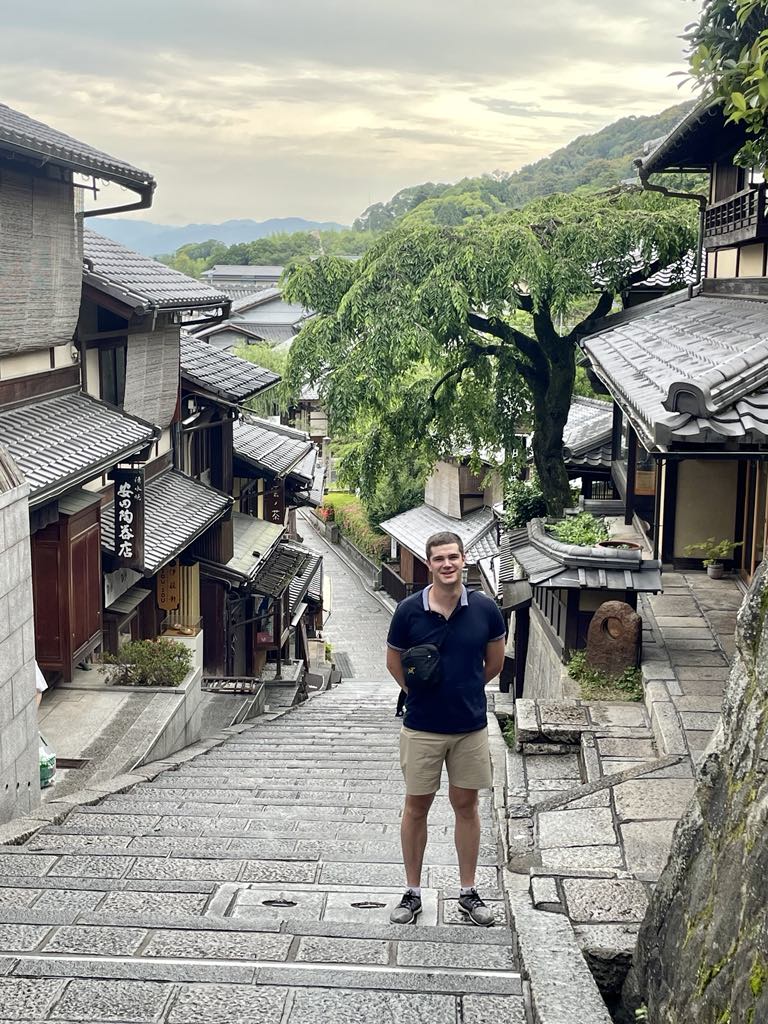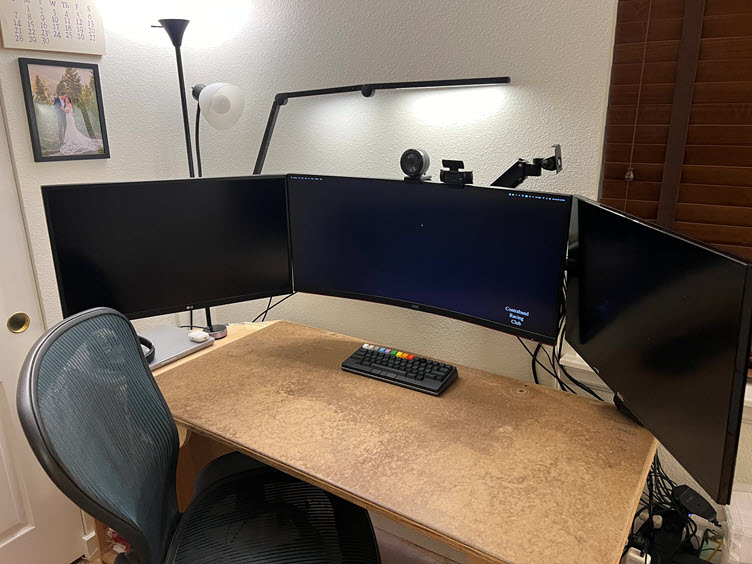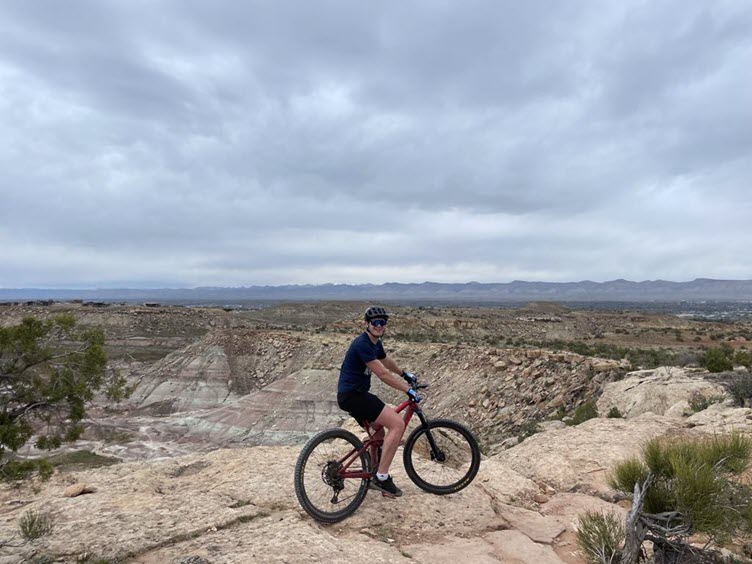In October of 2023, Happy Hacking Keyboards introduced a revolutionary new product series and its very first model, HHKB Studio. HHKB prides itself on being the perfect typing companion for the ultimate user, and with the always-evolving needs of typers, HHKB Studio allows creators of all kinds to create their masterpieces both efficiently and effectively. Today, we had the pleasure of discussing this new, innovative product with Senior Solutions Architect, Michael Mumma.
HHKB: Hello Michael, to start off, let’s hear a little about your background.
Michael: My name is Michael Mumma and from Cincinnati, Ohio and went to school at Miami University where I received my Computer Science degree. I’ve always loved bikes and eventually moved to Colorado to be able to bike every day of the summer. Now I live in Breckenridge, Colorado, and my wife and I have skied every winter and biked every summer. I work as a Senior Solutions Architect (AWS focus) for a consulting firm.
HHKB: What got you interested in programming?
Michael: Programming took my interest when in business school I realized classmates had interesting ideas for platforms or apps but no one to build out Proof of Concepts (POCs). After building a lot of POCs and quick platforms, I switched from finance to computer science -- which is where programming became one of my favorite tools for problem solving and a constant challenge.
HHKB: How did you get started in your career?
Michael: I started as a software developer, but realized I wanted to work on solutions that fundamentally changed organizations and how their people work day to day. Moving into the role of Solution Architect and working with cloud migrations allowed for that. My first role at GE Aviation was great to be able to solve GE-sized problems. I eventually had the opportunity to work in Italy with a subsidiary company where I felt the benefit of being able to work with a variety of clients. Working with different clients allowed for more strategic improvement opportunities along with seeing a variety of domains. Eventually I worked in setting up FedRAMP compliant landing zones with clients. Now I work for a consulting company called Slalom, where I now have the chance to work with a variety of clients in their designs and implementations.

The HHKB Studio has been a wonderful tool to make work more efficient. Michael Mumma
HHKB: What brought you to Slalom, and what do you like about working there?
Michael: What brought me to Slalom was the team I joined were all people that all genuinely desired to get better every day. Outside of the people I enjoy working at a consulting company that doesn’t have the feeling of a Big Four consulting company.
HHKB: What type of role do you currently occupy at your job?
Michael: I am an AWS Solutions Architect. I work with clients to develop and design AWS cloud designs. This can range from datacenter migrations to new landing zones and also work with teams to bring best practices to organizations. Then when engagements start, I work with the teams and develop (IAC) Infrastructure as Code with the teams. It’s a lot of Terraform and pipeline development.
HHKB: Interesting, how much programming comes with that role?
Michael: During projects, my day-to-day consists of about 85% programming, once the first phases are complete. The HHKB Studio has been a wonderful tool to make work more efficient.
HHKB: That is great to hear that HHKB Studio helps you work more efficiently. Back to your job, what programming languages and applications do you use for your work and outside of work?
Michael: For programming languages, at work I use Terraform, Python and bash scripting for pipelines. Outside of that, most of my personal projects fall under Python just out of ease of use and libraries. In terms of applications, for day to day work I am in Visual Studio Code the majority of the day implementing client solutions. In the pursuit of functional excellence, I have a configuration for VS Code that I send over to every client computer that I am working on. During work I spent time in terminals for a lot of commands to be tested before fully automating the process -- which is where the HHKB Studio been great to have the mouse scroll on the right gesture pad. Being able to quickly scroll back up through terminal outputs with terraform outputs has kept my hands on the keyboard, unlike before where I was always having to switch over to the mouse. Second major use is being able to leverage the left gesture pad as an arrow key for going back to in terminal history to grab commands.
Outside of that my time is spent working in system diagramming solutions like LucidChart. Where I’ve learned that drawing out solutions and having a common visual to talk to allows for people to be on the same page.
HHKB: What is your favorite aspect of your job?
Michael: My favorite part is enabling people to work at their jobs on what they enjoy working on. Getting to use AWS as a toolbox to solve organizational problems brings me joy when working. I can show people that the most mundane task can be automated away, and it really lets them work on what brings them joy. The job involves a lot of programming, but it’s nice to see solutions can be worked out by just talking with different teams and connecting them to solve problems they didn’t know they were both facing.
HHKB: That is a very great aspect and must be very rewarding. Switching gears now, what first got you into mechanical keyboards?
Michael: Originally, I got into mechanical keyboards for gaming. It started with a Razer BlackWidow Tournament which surprisingly did not help with getting out of Platinum in League of Legends. After that I worked towards finding the best keyboard I could at the time and ordered a Poker II which was my first taste of a 60% keyboard. It was nice but the MX Blues were too loud. Eventually, working in corporate offices and not wanting to disturb coworkers I moved to try MX Browns via the Das Keyboard Professional, but it was still loud when everyone was in an open setting. I found out “I am not that guy pal” when trying to use a MX Black keyboard and quickly sold it. And an MX Red keyboard without a bump / click felt like ghost typing. I eventually found HHKB and tried the Topre switches on the Professional HYBRID Type-S, and they were quiet enough to be brought into the office. Moving over to HHKB Studio, I’ve been enjoying the new switches and their volume. Their quietness allows me to bring Studio into the office.
HHKB: What do you like most about HHKB Studio?

The HHKB Studio has been the best keyboard I’ve found in that pursuit of excellence in physical tools as a software developer. Michael Mumma
Michael: One of my main focuses with programming has been focusing on software craftsmanship, with a focus on the tools that are used every day not being different than a carpenter perfecting his tools to perfect their craft. The HHKB Studio has been the best keyboard I’ve found in that pursuit of excellence in physical tools as a software developer. I also really enjoy the keyboard’s weight. HHKB Studio just feels solid on a surface where other keyboards I felt like would move them away. The frame of Studio feels stiffer as well.
HHKB: Do you own any other HHKBs?
Michael: I only have one other HHKB which is the HHKB Professional HYBRID Type-S (Snow, Stamped). It was my first taste before Studio was released. HHKB had been the cornerstone of what I was saving up for in the mechanical keyboard world since hearing about them on Reddit’s /r/MechanicalKeyboards/ and talking to fellow computer science students.
HHKB: How would you say the layout helps you?
Michael: To start, HHKB’s Control key placement has made every other keyboard feel wrong. Working with client laptops that are Windows OS and working on Windows servers has become so much easier. Windows feels like it’s meant for key binds instead of reaching like is required for regular keyboards.
Next, the 60% layout is the best 60% keyboard I’ve used for the functionality fit into such a compact size. I used a Poker II for a while till I couldn’t handle the lack of functionality. Being able to keep my hands on the keyboard the entire time through a workflow using the pointer and gesture pads in combination with key binds has been a game changer.
Also, the righthand side of the board arrows have been nice when combined with home + end + PgDn + PgUp being in the same area.
HHKB: What other features have you liked so far with HHKB Studio?
Michael: I really like the LED Bar with the four lights. This has been a huge improvement over the HYBRID Type-S. My Studio is normally switched between four computers for the normal workday. Being able to switch between them with ease of fn+control+
HHKB: We are glad you find the new LED Bar so helpful, especially for multi-device work. On the other hand, are there any other features you would like to see on the keyboard?
Michael: I think it would be cool to see a wrist pad that has cut outs that accommodates the bottom gesture pads. I test made one, but couldn’t get it to be low enough and still support a wrist. With that being said I use the Studio without a wrist rest normally so not a massive thing for me.

HHKB’s Control key placement has made every other keyboard feel wrong. Working with client laptops that are Windows OS and working on Windows servers has become so much easier. Michael Mumma
HHKB: What other equipment do you use in your set up?
Michael: I run two 27” 1440 monitors on the left and right. With a 34” Ultrawide 1440 as the center monitor. For cameras I run a Logitec c920 along with a Razer Kiyo Pro for the main client computer at the time. For a mouse, the main use of a mouse outside the pointer is when diagramming architectures. So, I use an Apple track pad on the side of the keyboard. I also run three to four computers per day.
HHKB: Has HHKB Studio helped improve your overall desk experience with your other tools?
Michael: As I said, I use three to four computers every day, so being able to seamlessly switch between them easily is superb. The bigger benefit of HHKB Studio, though, is I no longer need to run as many mouses on my desk. Cleaning up my desk has been great for focus and not having to remember the order of mouses on the desk. Truly one keyboard being able to accomplish so much makes for minimal movement off the keyboard.
HHKB: How does HHKB Studio’s design and features help with your work?
Michael: In a similar fashion to improving my desk space, HHKB Studio has been a game changer for working in the terminal because I do not have to take my hands off the keyboard. Now I can scroll through outputs via the mouse scroll gesture pad.

HHKB: That’s great to hear! Speaking of gesture pads, how do you use them?
Michael: I use the default gesture settings, and they help a lot with my programming experience and efficiency. I use Mouse left and right for medium length strings without breaks in them. Next, I use Mouse up and down for scrolling through history and navigating through VS code when programming to get to a further section. And finally, I use Mouse scroll gesture to get through outputs in terminal along with moving around VS Code for really large files.
HHKB: That does sound very efficient. Do you also use the integrated mouse functionalities with the pointing stick and mouse buttons?
Michael: Yes, and it’s been the main method for getting the other computer mouse off my desk. Cleaning up my desk. I use speed 2 and for mac I disabled mouse acceleration. Running $ defaults write -g com.apple.mouse.scaling -integer -1 disables the mouse acceleration and that makes a big difference.
HHKB: Very nice! We are glad you are able to take advantage of all the features of our new product. Now, moving back to you, what do you like to do in your free time?
Michael: I try to get the most out of my free time with as little friction as possible to do my hobbies. Right now, those are skiing in the winter and road / mountain biking in the summer. When I can’t be doing one of those, I’ve found the pursuit of functional excellence in home improvement to be a great hobby. Working through items that are used day to day and always testing new setups to minimize friction of task.

HHKB: What are you most excited about for 2024?
Michael: I am very excited to continue to learn Japanese and fly fish.
HHKB: Last question, where do you see yourself in 5 years? 10 years?
Michael: In 5 years, I hope to be working in Solution Architecture but having learned enough Japanese to work with Japanese organizations. Bringing over modernizations and helping organizations while learning from them as well.
In 10 years, I want to work towards building up AWS teams and enabling the team to be the best version of themselves while they work on projects they enjoy.
HHKB: That sounds like a great future ahead of you! Thank you so much for talking with us today, Michael, and we wish you all the best in the future. Happy Hacking!

